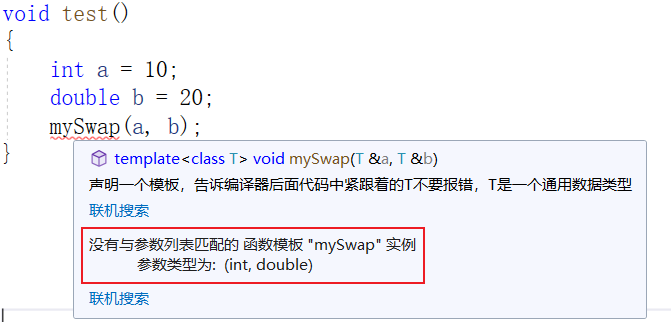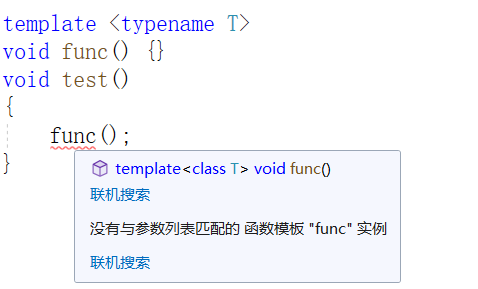•共勉“那些疯狂到以为自己能够改变世界的人,才能真正改变世界。”
苹果 “非同凡响” 广告·1997
•函数模板 介绍函数模板
- C++另一种编程思想称为 泛型编程 ,主要利用的技术就是模板
- C++提供两种模板机制:函数模板 和 类模板
语法格式
template <typename T>//声明一个模板,告诉编译器后面代码中紧跟着的 T 不要报错,T 是一个通用数据类型 函数声明或定义
- template:声明创建模板
- typename:表面其后面的符号是一种数据类型
- T:通用的数据类型,名称可以替换,通常为大写字母
作用
建立一个通用函数,其函数返回值类型和形参类型可以不具体制定,用一个虚拟的类型来代表。
举例说明
例如,对于如下交换函数:
void swapInt(int &a, int &b) { int tmp = a; a = b; b = tmp; }我们传递的参数只能是整数类型,如果我们想要交换 double 类型的呢?
那当然是重写一份啦~
void swapDouble(double& a, double& b) { double tmp = a; a = b; b = tmp; }对于这两份代码,你会发现除了参数类型不同外,交换的步骤都是相同的。
那如果要交换 short 类型的呢,在重写一份吗?
会不会过于啰嗦,下面就引出函数模板的强大之处。
我们可以这么写:
template <typename T>//声明一个模板,告诉编译器后面代码中紧跟着的T不要报错,T是一个通用数据类型 void mySwap(T& a, T& b) { T tmp = a; a = b; b = tmp; }利用函数模板实现数据交换,有两种调用方式:
- 自动类型推导
- 显示指定类型
void test() { int a = 10; int b = 20; mySwap(a, b);//1.自动类型推到 cout << "a = " << a << endl; cout << "b = " << b << endl; double c = 30; double d = 40; mySwap<double>(c, d);//2.显示指定类型 cout << "c = " << c << endl; cout << "d = " << d << endl; }对于方式 1,编译器会自动识别传递的参数类型,并做相应的调整:
注意事项 1
传递的参数类型必须是同种类型的,即必须推导出一致的数据类型 T 才可以使用。
比如就不能通过 mySwap 函数交换 int 和 double 类型的数据:
void test() { int a = 10; double b = 20; myswap(a, b); }由于 a,b 不是同种类型的,在编译阶段就会报错:
提示推导不出一致的 T 类型。
注意事项 2
必须遵循模板的声明和函数的声明一对一使用,即模板的声明只作用于紧挨着的函数声明。
比如下面这种代码就会报错:
template <typename T> void func1(T &a){} void func2(T &a){}
因为声明的函数模板 T 只对 func1 起作用,如果 func2 也想用,必须重新声明:
template <typename T> void func1(T &a) {} template <typename T> void func2(T &a) {}注意事项 3
模板必须要确定出 T 的数据类型,才可以使用。
比如如下代码就会报错:
template <typename T> void func() {} void test() { func(); }因为函数 func() 的声明紧挨着模板的声明,所以他俩就是一对一的关系,那么要想调用 func ,就必须给出 T 的数据类型;
不然编译阶段都不通过。
对于这种不含参数的函数模板,必须使用 显示指定类型 来调用:
template <typename T> void func() {} void test() { func<int>(); }其中 <int> 随便写个数据类型就行,作用就是告诉函数模板传递的 T 为 XX 类型 。
•学以致用有了函数模板的知识储备,下面来写一个排序函数,不管是传入 int 类型 还是 char 类型 都可以实现升序排列。
选择排序template <typename T> void mySwap(T& a, T& b) { T tmp = a; a = b; b = tmp; } template <typename T> void mySort(T arr[],int first,int last)//order [first, last) { for (int i = first; i < last; i++)//选择排序 { int minIndex = i; for (int j = i + 1; j < last; j++) { if (arr[j] < arr[minIndex]) minIndex = j; } mySwap(arr[i], arr[minIndex]); } }调用该排序函数template <typename T> void print(const T arr[], int first, int last)//输出数组[first, last) { for (int i = first; i < last; i++) cout << arr[i] << " "; cout << endl; } void test1() { //测试对整形数组进行排序 int arr[10]; for (int i = 0; i < 10; i++) arr[i] = rand()%20;//随机产生[0~20)之间的随机数 cout << "排序前:"; print(arr, 0, 10); mySort(arr, 0, 10); cout << "排序后:"; print(arr, 0, 10); } void test2() { //测试对字符型数组进行排序 char arr[10]; for (int i = 0; i < 10; i++) arr[i] = 'A'+rand() % 20;//随机产生[0~20)之间的随机数 cout << "排序前:"; print(arr, 0, 10); mySort(arr, 0, 10); cout << "排序后:"; print(arr, 0, 10); }CODE#include<bits/stdc++.h> using namespace std; template <typename T> void mySwap(T& a, T& b) { T tmp = a; a = b; b = tmp; } template <typename T> void mySort(T arr[],int first,int last)//order [first, last) { for (int i = first; i < last; i++)//选择排序 { int minIndex = i; for (int j = i + 1; j < last; j++) { if (arr[j] < arr[minIndex]) minIndex = j; } mySwap(arr[i], arr[minIndex]); } } template <typename T> void print(const T arr[], int first, int last)//输出数组[first, last) { for (int i = first; i < last; i++) cout << arr[i] << " "; cout << endl; } void test1() { //测试对整形数组进行排序 int arr[10]; for (int i = 0; i < 10; i++) arr[i] = rand()%20;//随机产生[0~20)之间的随机数 cout << "排序前:"; print(arr, 0, 10); mySort(arr, 0, 10); cout << "排序后:"; print(arr, 0, 10); } void test2() { //测试对字符型数组进行排序 char arr[10]; for (int i = 0; i < 10; i++) arr[i] = 'A'+rand() % 20;//随机产生[0~20)之间的随机数 cout << "排序前:"; print(arr, 0, 10); mySort(arr, 0, 10); cout << "排序后:"; print(arr, 0, 10); } int main() { test1(); test2(); return 0; }
•结尾咳咳,本次内容到此结束,完结撒花。




